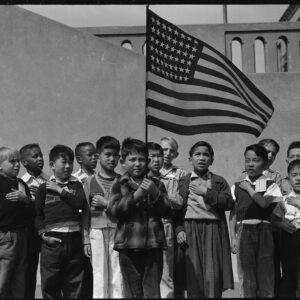Did you know more than patriotism was behind the Pledge of Allegiance’s creation? A master wordsmith penned the famous words for an unlikely reason — it was a clever marketing gimmick with a hidden purpose.
It started with Francis Bellamy.
Born into a devoutly Baptist family in Upstate New York, his minister father died before Bellamy was 10. The boy followed in his dad’s footsteps, studying theology and entering the ministry in the 1880s.
Much social experimentation was underway back then, and Bellamy evolved into something of a socialist Baptist. The problem was his congregations in New York and Massachusetts weren’t on board. As a result, he was bounced from church to church.
Dissatisfied with the ministry, he switched to a new line. The Youth’s Companion was a popular magazine in the Victorian Era. It instructed good girls and boys on ways to become even “gooder.” Bellamy got a job in its premium division.
For several years, The Youth’s Companion had sold U.S. flags to readers with the goal of placing one in every classroom. That, it was believed, would instill American values in youngsters. And the magazine made money from those sales, too. Patriotism and profits combined nicely for publisher Daniel Ford.
But by 1892, sales were slumping. Flags were on the walls in 26,000 schools around the country. Ford believed still more juice could be squeezed from this fruit. But how?
History came to the rescue.
With perfect timing, 1892 happened to be the 400th anniversary of Christopher Columbus’ arrival in the New World. The Youth’s Companion pushed for a Columbian Public School Celebration to mark the occasion — and to sell more school flags, too. Bellamy was tasked with making both happen.
He jumped into his new mission with evangelistic fervor. He promoted the event to a national convention of school superintendents. They liked the idea so much that they created a special committee to get local schools involved, with Bellamy as its chairman. All agreed the U.S. flag was central to the celebration.
But a nagging problem remained: How to get schools that hadn’t bought flags to purchase them.
Then inspiration hit. Bellamy proposed a Pledge of Allegiance to the flag to be recited by all American students on the same day.
Bellamy sat down at a desk and picked up a pen. Two hours later, his 23-word masterpiece was finished. The original Pledge said: “I pledge allegiance to my Flag and to the Republic for which it stands, one nation, indivisible, with liberty and justice for all.”
The Pledge appeared in the Sept. 8, 1892, edition of The Youth’s Companion. The gimmick worked. It’s pretty hard to say the Pledge without a flag (wink, wink). The desire to be part of the big event spurred the holdout schools to purchase Old Glory. The magazine sold thousands more flags.
And on October 21 of that year, millions of students recited the Pledge in unison for the very first time.
There was something else, too. The original Pledge was said with students standing and giving the “Bellamy Salute,” the traditional Roman salute from the time of Caesar. That worked fine in 1892. But by the 1920s and ’30s, first Fascists in Italy and later Nazis in Germany were using the same salute, but with a sinister meaning. When the U.S. entered World War II, kids standing with outstretched arms wasn’t such a good idea. So in 1942, Congress amended the Flag Code to say the Pledge should be recited the way we know it today, with the right hand over the heart.
In fairness, Bellamy sincerely believed his efforts instilled “Americanism” in kids living amid a flood of “alien immigration.” But he also put a lot of bucks in publisher Ford’s pockets, too.
Bellamy seems to have had a change of heart toward money himself. He switched from socialist to capitalist and enjoyed a lucrative career as a forerunner to Madison Avenue “Madmen,” promoting business giants Westinghouse and Allied Chemicals.
The Pledge underwent changes over the years, too, the biggest being in 1954 when Congress added the now familiar words “under God.”
Today, 47 states require it to be recited during the school day. People know the short, direct-to-the-point Pledge better than the Declaration of Independence, the Constitution, and the Bill of Rights. Those 31 simple words remind us of the essence of what America is all about, and reciting it daily unites us as a nation.
Sure, the original idea was based on the desire to make a few bucks. But the Pledge also produced a lot of good over the years, and that is, in the words of another successful advertisement gimmick, priceless.
Please follow DVJournal on social media: Twitter@DVJournal or Facebook.com/DelawareValleyJournal

